Great Bear Resources Ltd (TSXV: GBR) (OTCQX: GTBAF) has discovered a new gold zone in drilling at its 100% owned flagship Dixie Project, in the Red Lake district of Ontario.
“We recently resumed drilling near the Hinge and Limb zones and discovered a new, high-grade gold zone west of those targets,” President and CEO, Chris Taylor, said.
“The new ‘Midwest’ zone closely resembles the style of gold mineralisation observed at the Dixie Limb zone; both occur at the sheet-like contacts between different basalt units and consist of silica-sulphide replacement style mineralisation including high-grade gold.
“Several historical holes which tested the Limb zone, did not penetrate far enough to the west to intersect the Midwest zone. In addition to drilling other new, untested basalt contacts, the company will re-enter and extend previously drilled holes into the Midwest area.
“Additionally, ongoing drilling of the LP Fault zone continues to return significant gold intervals at depths ranging from bedrock surface to over 600 vertical metres.”
New Midwest Zone Drilling Highlights
- Drill hole DL-071 intersected the new “Midwest” zone, located 275 metres northwest of the Hinge zone and 250 metres south of the Dixie Limb zone, assaying 20.27 g/t gold over 1.75 metres from 812.35 to 814.10 metres downhole. The total mineralized interval was 5.69 g/t gold over 7.05 metres from 809.95 to 817.00 metres downhole. Table 1.
- The new discovery consists of high-grade gold in silica-sulphide replacement alteration at the subvertical planar contact between two basalt flows and is most similar to the Dixie Limb zone in style.
- Until this discovery, it was thought that the only mineralized basalt-basalt contact occurred at the Dixie Limb zone. It is now confirmed that additional basalt-basalt contacts can also localize silica-sulphide replacement mineralization including high-grade gold.
- Great Bear’s drilling and geophysical data suggest additional basalt-basalt contacts may occur within the mafic volcanic package southwest of the LP Fault zone, defining new drill targets.
All significant gold zones at Dixie occupy a 1.4 kilometre wide “dilation zone”, where many geological contacts and structures are mineralized. A report on seismic surveys by Zeng and Calvert, 2006 presents an interpretation that this structural zone reaches the base of the continental crust.
At the Dixie project, the zone contains a broad structural corridor with more than 18 kilometres of strike length. Gold has been drilled along 11 kilometres of strike length to date. In addition to ongoing drilling of the LP Fault, Phase 2 drilling will continue to test various new targets such as the new Midwest zone within this broad structurally dilated and mineralized corridor.
New LP Fault Drilling Highlights
Ongoing LP Fault drilling continues to systematically expand gold mineralization, including at depth. Current drill holes targeted the zone at various points along 2.9 kilometres of strike length, between bedrock surface and approximately 600 metres vertical depth.
The new Midwest zone was discovered in a previously undrilled area in a 200 to 300 metre step-out hole near the western margin of the newly planned drill grid.
The Hinge zone was discovered by Great Bear in 2018 and consists of multiple sub-parallel “Red Lake style” high-grade gold-bearing, anastomosing quartz veins hosted by mafic rocks. High-grade gold frequently concentrates in steeply-plunging shoot-like mineralized zones, as is typical in the Red Lake district.
The adjacent Dixie Limb zone was discovered by Teck Resources Ltd. in the 1980’s and was the first gold zone explored by Great Bear.
The Limb zone consists of silica-sulphide replacement mineralisation containing mid- to high-grade gold located at the subvertical contact between two basalt units.
For further information please visit: https://www.greatbearresources.ca/












